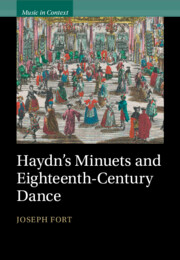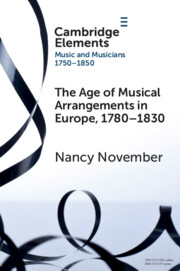Refine search
Actions for selected content:
27 results
6 - Haydn in Plain Sight: A Reception History of Matisse’s The Music Lesson
-
-
- Book:
- Haydn Studies 2
- Published online:
- 18 October 2025
- Print publication:
- 16 October 2025, pp 127-154
-
- Chapter
- Export citation
1 - The Many Haydns of Musicology
-
-
- Book:
- Haydn Studies 2
- Published online:
- 18 October 2025
- Print publication:
- 16 October 2025, pp 1-14
-
- Chapter
- Export citation
3 - Listening Again to Haydn’s Night Watchman
-
-
- Book:
- Haydn Studies 2
- Published online:
- 18 October 2025
- Print publication:
- 16 October 2025, pp 43-69
-
- Chapter
- Export citation
9 - ‘Admired across the Sea’: Importing Late Haydn into Early New Zealand
-
-
- Book:
- Haydn Studies 2
- Published online:
- 18 October 2025
- Print publication:
- 16 October 2025, pp 207-232
-
- Chapter
- Export citation
4 - Haydn’s Last Heroine: Hanne, The Seasons, and the Culture of Sensibility
-
-
- Book:
- Haydn Studies 2
- Published online:
- 18 October 2025
- Print publication:
- 16 October 2025, pp 70-100
-
- Chapter
- Export citation
5 - Framing Haydn: Canons ‘As Pictures’ in the Composer’s Kabinett
-
-
- Book:
- Haydn Studies 2
- Published online:
- 18 October 2025
- Print publication:
- 16 October 2025, pp 101-126
-
- Chapter
- Export citation
2 - Understanding Haydn’s Il ritorno di Tobia through Tonkünstler-Societät Oratorio Traditions Established by Its Founder Florian Leopold Gassmann
-
-
- Book:
- Haydn Studies 2
- Published online:
- 18 October 2025
- Print publication:
- 16 October 2025, pp 15-42
-
- Chapter
- Export citation
7 - The Premiere of Haydn’s Orfeo in Florence (1951)
-
-
- Book:
- Haydn Studies 2
- Published online:
- 18 October 2025
- Print publication:
- 16 October 2025, pp 155-181
-
- Chapter
- Export citation
Epilogue
-
- Book:
- Haydn's Minuets and Eighteenth-Century Dance
- Published online:
- 12 September 2025
- Print publication:
- 02 October 2025, pp 210-213
-
- Chapter
- Export citation
4 - A Somatic Enquiry into the Minuet
-
- Book:
- Haydn's Minuets and Eighteenth-Century Dance
- Published online:
- 12 September 2025
- Print publication:
- 02 October 2025, pp 137-176
-
- Chapter
- Export citation
5 - Somatic Analysis of the Concert Minuets
-
- Book:
- Haydn's Minuets and Eighteenth-Century Dance
- Published online:
- 12 September 2025
- Print publication:
- 02 October 2025, pp 177-209
-
- Chapter
- Export citation
1 - The Dance Culture of Late Eighteenth-Century Vienna
-
- Book:
- Haydn's Minuets and Eighteenth-Century Dance
- Published online:
- 12 September 2025
- Print publication:
- 02 October 2025, pp 11-61
-
- Chapter
- Export citation
Introduction
-
- Book:
- Haydn's Minuets and Eighteenth-Century Dance
- Published online:
- 12 September 2025
- Print publication:
- 02 October 2025, pp 1-10
-
- Chapter
- Export citation
3 - The Music of the Viennese Minuet
-
- Book:
- Haydn's Minuets and Eighteenth-Century Dance
- Published online:
- 12 September 2025
- Print publication:
- 02 October 2025, pp 98-136
-
- Chapter
- Export citation

Haydn's Minuets and Eighteenth-Century Dance
-
- Published online:
- 12 September 2025
- Print publication:
- 02 October 2025

The Age of Musical Arrangements in Europe, 1780–1830
-
- Published online:
- 04 September 2023
- Print publication:
- 28 September 2023
-
- Element
- Export citation
Seven - The Classical Period
-
- Book:
- A History of Stringed Keyboard Instruments
- Published online:
- 03 April 2022
- Print publication:
- 21 April 2022, pp 362-445
-
- Chapter
- Export citation
3 - Beethoven’s Unfinished Symphonies
-
-
- Book:
- Beethoven Studies 4
- Published online:
- 26 September 2020
- Print publication:
- 17 September 2020, pp 44-81
-
- Chapter
- Export citation
2 - Beethoven’s ‘Watershed’? Eroica’s Contexts and Periodisation
- from Part I - Context and Genesis
-
-
- Book:
- The Cambridge Companion to the <I>Eroica</I> Symphony
- Published online:
- 04 June 2020
- Print publication:
- 25 June 2020, pp 24-42
-
- Chapter
- Export citation
6 - When Does the Sublime Stop? Cavatinas and Quotations in Haydn’s Seasons
-
-
- Book:
- Music and the Sonorous Sublime in European Culture, 1680–1880
- Published online:
- 30 April 2020
- Print publication:
- 28 May 2020, pp 141-176
-
- Chapter
- Export citation
